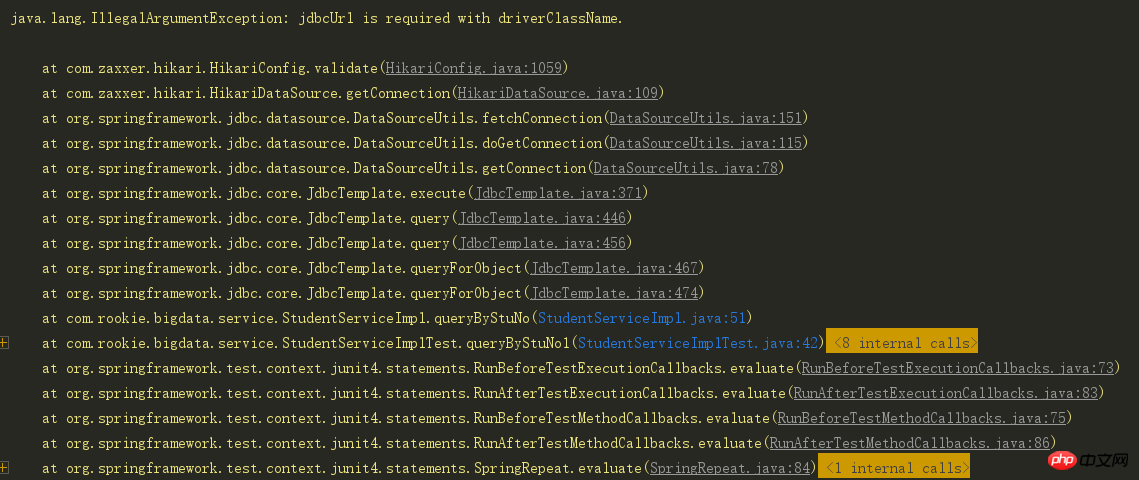
Der Inhalt dieses Artikels befasst sich mit der Methode von Springboot zur Konfiguration von JdbcTemplate unter Verwendung mehrerer Datenquellen. Ich hoffe, dass er für Sie hilfreich ist.
Springboot-Konfiguration mit mehreren Datenquellen, der Code lautet wie folgt
DataSourceConfig
package com.rookie.bigdata.config;
import org.springframework.beans.factory.annotation.Qualifier;
import org.springframework.boot.context.properties.ConfigurationProperties;
import org.springframework.boot.jdbc.DataSourceBuilder;
import org.springframework.context.annotation.Bean;
import org.springframework.context.annotation.Configuration;
import org.springframework.context.annotation.Primary;
import org.springframework.jdbc.core.JdbcTemplate;
import javax.sql.DataSource;
/**
* @author
* @date 2018/10/10
*/
@Configuration
public class DataSourceConfig {
@Bean(name = "primaryDataSource")
@Qualifier("primaryDataSource")
@ConfigurationProperties(prefix="spring.datasource.primary")
public DataSource primaryDataSource() {
return DataSourceBuilder.create().build();
}
@Bean(name = "secondaryDataSource")
@Qualifier("secondaryDataSource")
@Primary
@ConfigurationProperties(prefix="spring.datasource.secondary")
public DataSource secondaryDataSource() {
return DataSourceBuilder.create().build();
}
@Bean(name = "primaryJdbcTemplate")
public JdbcTemplate primaryJdbcTemplate(
@Qualifier("primaryDataSource") DataSource dataSource) {
return new JdbcTemplate(dataSource);
}
@Bean(name = "secondaryJdbcTemplate")
public JdbcTemplate secondaryJdbcTemplate(
@Qualifier("secondaryDataSource") DataSource dataSource) {
return new JdbcTemplate(dataSource);
}
}StudentServiceImpl
package com.rookie.bigdata.service;
import com.rookie.bigdata.domain.Student;
import org.springframework.beans.factory.annotation.Autowired;
import org.springframework.beans.factory.annotation.Qualifier;
import org.springframework.jdbc.core.JdbcTemplate;
import org.springframework.stereotype.Service;
/**
* @author
* @date 2018/10/9
*/
@Service
public class StudentServiceImpl implements StudentService {
@Autowired
@Qualifier("primaryJdbcTemplate")
private JdbcTemplate jdbcTemplate;
@Autowired
@Qualifier("secondaryJdbcTemplate")
private JdbcTemplate jdbcTemplate2;
/**
* 采用第一个暑假源进行插入数据
* @param student
*/
@Override
public void create(Student student) {
jdbcTemplate.update("INSERT INTO student(stu_no,name,age)VALUE (?,?,?)", student.getStuNo(), student.getName(), student.getAge());
}
/**
* 第一个数据源进行插入数据
* @param stuNo
*/
@Override
public void deleteByNo(Integer stuNo) {
jdbcTemplate.update("DELETE FROM student WHERE stu_no=?", stuNo);
}
/**
* 第二个数据源进行查询数据
* @param stuNo
* @return
*/
@Override
public Integer queryByStuNo(Integer stuNo) {
return jdbcTemplate2.queryForObject("select count(1) from student", Integer.class);
}
}Konfiguration Datei application.properties
spring.datasource.primary.url=jdbc:mysql://localhost:3306/springboot spring.datasource.primary.username=root spring.datasource.primary.password=root spring.datasource.primary.driver-class-name=com.mysql.jdbc.Driver spring.datasource.secondary.url=jdbc:mysql://localhost:3306/springboot spring.datasource.secondary.username=root spring.datasource.secondary.password=root spring.datasource.secondary.driver-class-name=com.mysql.jdbc.Driver
Der Testcode lautet wie folgt:
package com.rookie.bigdata.service;
import com.rookie.bigdata.domain.Student;
import org.junit.Test;
import org.junit.runner.RunWith;
import org.springframework.beans.factory.annotation.Autowired;
import org.springframework.boot.test.context.SpringBootTest;
import org.springframework.test.context.junit4.SpringRunner;
/**
* @author liuxili
* @date 2018/10/10
*/
@RunWith(SpringRunner.class)
@SpringBootTest
public class StudentServiceImplTest {
@Autowired
private StudentServiceImpl studentService;
@Test
public void create1() throws Exception {
Student student = new Student();
student.setStuNo(1L);
student.setName("张三");
student.setAge(23);
studentService.create(student);
}
@Test
public void deleteByName1() throws Exception {
studentService.deleteByNo(1);
}
@Test
public void queryByStuNo1() throws Exception {
System.out.println(studentService.queryByStuNo(1));
}
}wird bei der Ausführung die folgende Ausnahme haben. Der Vorgang schlägt fehl und es wird eine java.lang.IllegalArgumentException gemeldet: jdbcUrl ist mit DriverClassName erforderlich. Ausnahme

Nachdem ich die Informationen überprüft habe, habe ich festgestellt, dass der Grund für dieses Problem in der Springboot-Version liegt. Die in diesem Beispiel verwendete Springboot-Version ist 2.0.5 Wenn die Version auf eine Version vor 1.5 geändert wird, treten die oben genannten Probleme nicht auf. Tatsächlich gibt es zwei Hauptlösungen, um die obige Ausnahme zu lösen:
Lösung 1:
Ändern Die application.properties-Konfigurationsdatei gemäß dem folgenden Plan wie folgt: Nach Abschluss der Änderung tritt die obige Ausnahme nicht erneut auf
spring.datasource.primary.jdbc-url=jdbc:mysql://localhost:3306/springboot spring.datasource.primary.username=root spring.datasource.primary.password=root spring.datasource.primary.driver-class-name=com.mysql.jdbc.Driver spring.datasource.secondary.jdbc-url=jdbc:mysql://localhost:3306/springboot spring.datasource.secondary.username=root spring.datasource.secondary.password=root spring.datasource.secondary.driver-class-name=com.mysql.jdbc.Driver
Option 2:
Die ursprüngliche application.properties-Konfiguration Die Datei wird nicht geändert und die Informationen in der DataSourceConfig-Klasse werden wie folgt geändert: Nach Abschluss der Änderung wird auch die Ausnahme angezeigt Es sieht nicht mehr so aus, als ob sie normal ausgeführt werden kann
application.properties
spring.datasource.primary.url=jdbc:mysql://localhost:3306/springboot spring.datasource.primary.username=root spring.datasource.primary.password=root spring.datasource.primary.driver-class-name=com.mysql.jdbc.Driver spring.datasource.secondary.url=jdbc:mysql://localhost:3306/springboot spring.datasource.secondary.username=root spring.datasource.secondary.password=root spring.datasource.secondary.driver-class-name=com.mysql.jdbc.Driver
DataSourceConfig
package com.rookie.bigdata.config;
import org.springframework.beans.factory.annotation.Qualifier;
import org.springframework.boot.autoconfigure.jdbc.DataSourceProperties;
import org.springframework.boot.context.properties.ConfigurationProperties;
import org.springframework.context.annotation.Bean;
import org.springframework.context.annotation.Configuration;
import org.springframework.context.annotation.Primary;
import org.springframework.jdbc.core.JdbcTemplate;
import javax.sql.DataSource;
/**
* @author
* @date 2018/10/10
*/
@Configuration
public class DataSourceConfig {
@Bean(name = "primaryJdbcTemplate")
public JdbcTemplate primaryJdbcTemplate(
@Qualifier("primaryDataSource") DataSource dataSource) {
return new JdbcTemplate(dataSource);
}
@Bean(name = "secondaryJdbcTemplate")
public JdbcTemplate secondaryJdbcTemplate(
@Qualifier("primaryDataSource") DataSource dataSource) {
return new JdbcTemplate(dataSource);
}
@Primary
@Bean(name = "primaryDataSourceProperties")
@Qualifier("primaryDataSourceProperties")
@ConfigurationProperties(prefix = "spring.datasource.primary")
public DataSourceProperties primaryDataSourceProperties() {
return new DataSourceProperties();
}
@Bean(name = "secondaryDataSourceProperties")
@Qualifier("secondaryDataSourceProperties")
@ConfigurationProperties(prefix = "spring.datasource.secondary")
public DataSourceProperties secondaryDataSourceProperties() {
return new DataSourceProperties();
}
@Primary
@Bean(name = "primaryDataSource")
@Qualifier("primaryDataSource")
@ConfigurationProperties(prefix = "spring.datasource.primary")
public DataSource primaryDataSource() {
return primaryDataSourceProperties().initializeDataSourceBuilder().build();
}
@Bean(name = "secondaryDataSource")
@Qualifier("secondaryDataSource")
@ConfigurationProperties(prefix = "spring.datasource.secondary")
public DataSource secondaryDataSource() {
return primaryDataSourceProperties().initializeDataSourceBuilder().build();
}
}An diesem Punkt verwendet Springboot mehrere Datenquellen, um JdbcTemplate zu konfigurieren und hat eine perfekte Lösung
Das obige ist der detaillierte Inhalt vonSpringboot verwendet mehrere Datenquellen, um JdbcTemplate zu konfigurieren. Für weitere Informationen folgen Sie bitte anderen verwandten Artikeln auf der PHP chinesischen Website!
 Schritte zur SpringBoot-Projekterstellung
Schritte zur SpringBoot-Projekterstellung
 Was ist der Unterschied zwischen j2ee und springboot?
Was ist der Unterschied zwischen j2ee und springboot?
 Was ist Vuex?
Was ist Vuex?
 Können Douyin-Kurzvideos nach dem Löschen wiederhergestellt werden?
Können Douyin-Kurzvideos nach dem Löschen wiederhergestellt werden?
 So erstellen Sie eine ISO-Datei
So erstellen Sie eine ISO-Datei
 Was ist die Tastenkombination für die Pinselgröße?
Was ist die Tastenkombination für die Pinselgröße?
 Der Apple Store kann keine Verbindung herstellen
Der Apple Store kann keine Verbindung herstellen
 Grundbausteine von Präsentationen
Grundbausteine von Präsentationen